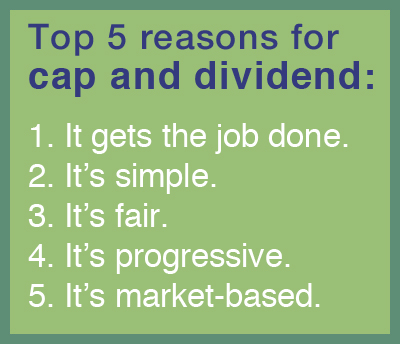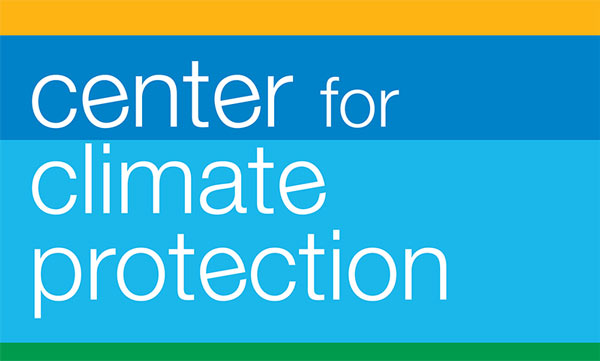For several years, The Center for Climate Protection has been advocating for a carbon price that returns revenues to people. The California Climate Credit is one of the first times that this has been put into practice.
 A Price Signal for Climate Protection
A Price Signal for Climate Protection
Why do we need a price on carbon? To reflect the actual cost to our economy and environment of fossil fuel. When we have to pay more to pollute the atmosphere for our energy needs, we will consume less fossil fuel based energy and more renewable energy. We can do this by “capping” the greenhouse gases that are allowed to be put into the atmosphere and making polluters pay when they emit emissions under this cap.
At the same time we need a policy that addresses the regressive impact of rising energy prices on middle and lower income people that such a carbon price will contribute to. That is why we believe a substantial portion of any revenue collected by the state from a carbon tax or fee should be returned to citizens in the form of a dividend, rebate, or credit. This is sometimes referred to as “Cap and Dividend.” The good news is that in California, in part because of our efforts, we now have both.
We need your help to go further
The Center for Climate Protection was at the forefront of this effort, and we will continue to advocate for climate dividends, but we could use your help. You can help build on our success in California by donating the amount your received for your climate credit to the Center for Climate Protection. Click here and be sure to type “Climate Credit” in the comments section at the bottom. Also, if you would like to have your donation support Commons Share, a project of Mike Sandler, one of the Center’s co-founders, donate here and type “Commons Share” in the dedication box.
Why are climate dividends/credits so important?
Pollution is not free. It creates health problems, harms the environment. Making companies pay for their pollution captures some of those costs, which can be returned back to all of us through dividends. The dividend converts the carbon pollution going into the atmosphere into money going into your pocket. With dividends, you can come out ahead by taking action to reduce your impact and your costs. The amount of your dividend will stay the same, even if you reduce your energy use.
 How it works:
How it works:
Companies that generate energy pay into a fund that compensates everyone for the pollution emitted into the sky we all share.
How does The Center for Climate Protection promote climate dividends?
The Center for Climate Protection has focused on getting a price on carbon that reflects the actual cost of fossil fuel to our economy and environment, and includes climate dividends. Since 2007 the Center has been educating policy makers, stakeholders and the public with the aim of including climate dividends in California’s implementation of AB32, the Global Warming Solutions Act.
We have attended dozens of hearings, submitted comments, and organized events to educate policymakers about climate dividends.
The CPUC’s adoption of the first climate dividend came about because policy makers were educated. We weren’t the only ones there, but we were an important part of that. We had other victories along the way leading up to this.
A State-appointed panel of experts, called the Economic and Allocation Advisory Committee (EAAC), studied the best strategy to allocate the revenue raised by the cap & trade program. The EAAC’s January 10th, 2010 report recommended that the largest share – roughly 75% of allowance value – should be returned to California households. According to EAAC figures, this dividend translates to $388 in 2012 for a family of four, rising to $1,036 by 2020, adding a total of $7,004 to family incomes over the 8 year period. The Center for Climate Protection continues to reach out to lawmakers to incorporate this recommendation into future legislation. If we are successful, it will be a huge victory for California’s economy and the environment!
More resources:
Mike Sandler in Huffington Post Green 7-29-15: Five Ways to Improve California’s Cap and Trade System
Barry Vesser and Mike Sandler in Santa Rosa Press Democrat 2-13-13: Cap and Trade Funds On Way
Mike Sandler in Huffington Post Green 12-5-12: The Birth of Carbon Pricing and Delivering California’s First ‘Climate Dividend’
Alex Jackson at NRDC 12-20-13: California PUC Approves First-of-its-Kind “Climate Dividend” for California Households
AOL Energy Blog 1-9-13: California Ratepayers to Receive Cap-and-Trade Dividend
San Francisco Chronicle 11-16-12: Cap and trade may be plum for homeowners
Mike Sandler in Huffington Post Green 5-30-12: Climate Dividends: California’s Chance to Change Hearts and Minds
James K.Boyce & Matthew Riddle., CLEAR Economics, UMass Amherst, March 2010
Peter Barnes, Americans for Equitable Climate Solutions and Corporation for Enterprise Development, “Sky Trust Initiative: Economy-Wide Proposal to Reduce U.S. Carbon Emissions”


